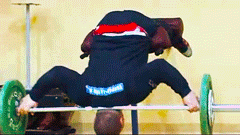has been getting some play on the intertubes lately. Here's a piece in that vein I saw attributed to Glenn a couple years back, same idea:
GAIN WEIGHT WITH CONCENTRIC MOVEMENTS - Attributed to Glenn Pendlay
As most of you know, I train athletes and not bodybuilders, so often the methods I use are geared mostly towards strength with little regard to gaining size, or even geared specifically toward gaining strength WITHOUT any size gain for athletes in specific weight classes.
that having been said, I usually have a hard time keeping weight off the guys, the volume of training we do often means that the guys must watch the diet really close to avoid growing out of their proper weight class.
now, having said all that, there are times when I have a guy that needs to move up a weight class quickly, for instance I recently had a guy that needed to move from the 77kilo weight class to the 85kilo (or from 169lbs to 187lbs) weight class because in his particular division the competition was actually easier at 85.
This particular guy usually trains about 10-12lbs overweight, so I actually had to move him from 180lbs to about 200lbs in 8 weeks, hopefully with no body fat increase, and of course with no drugs. I thought id share one of the ways I have accomplished this quick weight gain in the past and how I did it in this case. In case you wondered, he did accomplish this, weighed 201lbs 2 weeks before competition, and is now cutting for competition; he’s weighing 195 now one week out, most of the rest well sweat off the day of weigh in.
the best way to accomplish weight gain is with of course more food and increased training volume, but I run into a problem here because my guys are squatting hard 3 days a week already, and doing maximal lifts in heavy leg and back exercises like the snatch and clean and jerk 6 days a week already... so adding volume in the conventional way would quickly result in an athlete breaking down.
So I use an idea that didn’t start with Westside, but has been recently popularized by them, concentric only exercise. The good thing about this is that it seems to have a good effect on the body, but doesn’t really make you sore, and doesn’t seem to affect recovery that much; in some athletes it seems to even help it.
The way I structure the workouts is this, the regular training around noon, and the extra workouts around 6 or 7 pm. typical exercises are as follows.
Walking up stairs with weight, taking the elevator down. For this I have a long, thin bag filled with sand, actually several of them. An athlete takes a bag, say a 50lb bag, and walks up 2 flights of stairs, then walks to the elevator and rides it back down.
Heavy ball throws. I have various bags and balls weighing between 20 and 100lbs. the athlete gets his arms around one on the ground, then with a clean or snatch type motion throws it up and behind them. It hits the ground; they turn around and throw it back. We usually do 10 throws at a time.
Various sled pulling. This is pure Westside; they have come up with many variations of this. a couple that we use are simply to attach a rope from the sled to the waist, usually around a weight belt, and walk 40 or 50 yards taking long, straight legged strides. for the upper body, we use two ropes, each with a handle, and for instance do a bench press type motion to pull the sled forward, then walk a step, then press again, etc. or turn around and do the same thing with a row motion. we also put the rope between our legs, and face away from the sled... as you take a step, straighten the body slightly, this pulls the sled forward. Take another step to take the slack out, and then do it again.
all of these things work the major muscle groups with concentric only action... adding to the workload but not compromising recovery ability that much, as long as you get extra sleep and remember to take in more food at least. Using these sorts of methods seems to allow athletes to handle more workload than they could with only normal exercises, but it’s important I think to time the workouts right. You want to do these "extra" workouts 4-6 hours after your normal workouts if possible. I know others who have done their regular workouts in the evenings, and gotten up and done these extra workouts in the mornings and had good results, but I haven’t tried that much.
I am not really sure how these types of things would work for bodybuilders... however I have to think that they would in fact work... I mean one of the reasons I don’t use them more in regular training is that it tends to make it too hard to keep a guys weight. They seem to be particularly effective for adding mass to the hamstrings, calves, glutes, and the spinal erectors and also upper back.
one other thing, we alter the weight we use for each day much as Westside does... in other words, if you do it 3 days in a row, the second day you use half the weight you used on the first day, the third day half of what you used on the second day, and then you start over again with 100% weight. If any of you bodybuilders out there thinks about trying this, I’d is interested to hear how it worked for you.



